#Advanced Catalysts
Explore tagged Tumblr posts
Text
Refinery Catalyst Market: Driving Efficiency, Sustainability, and Growth in Energy and Industry

In the rapidly evolving energy landscape, refinery catalysts are critical to refining crude oil into high-quality products such as gasoline, diesel, and jet fuel. Beyond efficiency, they help refineries meet stricter environmental standards and reduce operational costs. As global energy demands rise and regulations tighten, the refinery catalyst market continues to innovate, creating opportunities for sectors such as oil & gas, automotive, and environmental industries.
Market Overview
The refinery catalyst market is experiencing steady growth, fueled by a heightened focus on sustainability, operational efficiency, and regulatory compliance. The global refinery catalyst market is valued at USD 5.6 billion in 2024 and is projected to reach USD 6.8 billion by 2029, growing at 4.0% cagr from 2024 to 2029. The key categories of catalysts include:
FCC (Fluid Catalytic Cracking) Catalysts: Widely used to break heavy hydrocarbons into lighter, more valuable products like gasoline and propylene.
Hydrotreating Catalysts: Remove impurities such as sulfur and nitrogen, ensuring fuel meets ultra-low sulfur standards.
Hydrocracking Catalysts: Convert heavy hydrocarbons into cleaner fuels, such as kerosene and diesel.
Catalytic Reforming Catalysts: Increase the octane rating of fuels, meeting the performance needs of modern engines.
Key Drivers of Growth
1. Increasing Energy Demand
As developing economies grow, their energy consumption surges, creating a higher demand for refined products. Refinery catalysts enable refiners to maximize output and quality, making them essential tools in addressing this demand.
2. Stricter Environmental Standards
Governments worldwide are implementing more rigorous emission standards, such as Euro 6 and IMO 2020 low-sulfur marine fuel regulations. Advanced hydrotreating and hydrocracking catalysts help refineries produce cleaner fuels to comply with these mandates, particularly for automotive and shipping industries.
3. Petrochemical Industry Growth
Beyond fuel, catalysts are integral to producing petrochemicals like ethylene and propylene, which are foundational to plastics, textiles, and specialty chemicals. As these industries expand, so does the need for advanced catalytic processes.
4. Technological Innovations
The introduction of nano-based catalysts and other high-performance technologies has revolutionized the market. These advancements provide greater efficiency, selectivity, and durability, reducing waste and boosting refinery productivity.
Challenges in the Market
While opportunities abound, the market faces certain hurdles:
Oil Price Volatility: Fluctuating crude oil prices impact refinery investments in catalyst upgrades.
Renewable Energy Transition: The global shift towards renewable energy sources is influencing fossil fuel dependency.
Spent Catalyst Disposal: Recycling spent catalysts, which often contain hazardous materials, remains a complex and costly process.
Emerging Trends
1. Cleaner Fuel Production
The focus on reducing carbon footprints has led to innovations in catalysts for ultra-low sulfur diesel (ULSD) and high-octane gasoline production. These are crucial for reducing emissions in the automotive sector.
2. AI Integration in Refineries
Artificial intelligence is optimizing catalyst usage and refinery operations by predicting wear, improving process efficiency, and minimizing downtime.
3. Circular Economy Practices
Catalyst manufacturers are increasingly recycling spent catalysts to recover valuable metals like platinum and palladium. These practices lower costs and align with sustainability goals.
4. Regional Dynamics
Asia-Pacific: Rapid industrialization and new refinery projects in India, China, and Southeast Asia drive significant demand.
North America: The rise of shale gas and tight oil production supports advanced catalytic processes.
Middle East & Africa: Investments in large-scale refineries and petrochemical complexes are expanding market opportunities.
Applications Across Industries
Oil & Gas: Refinery catalysts are indispensable for producing cleaner, high-quality fuels.
Automotive: The shift towards cleaner transportation fuels ties directly to the automotive industry's sustainability goals.
Catalyst Manufacturing: The demand for specialized, high-performance catalysts fosters innovation in production techniques.
Environmental Sector: Catalysts help minimize industrial emissions, contributing to global efforts to combat climate change.
Download PDF Brochure :
The refinery catalyst market serves as a cornerstone for industries striving for efficiency and sustainability. With innovations in catalytic technologies and growing adoption of eco-friendly practices, the market is not only addressing current energy challenges but also shaping a more sustainable future. For decision-makers in oil & gas, automotive, energy, and environmental industries, embracing advancements in refinery catalysts can unlock new growth opportunities and align operations with global environmental goals.
As the demand for cleaner fuels and petrochemicals grows, refinery catalysts will continue to lead the way in delivering superior performance, reduced emissions, and enhanced productivity—an essential step toward a greener tomorrow.
#High Octane Fuels#Refinery Catalysts#Oil and Gas Industry#Automotive Performance#Fuel Efficiency#Sustainable Energy#Catalyst Technology#Emission Control#Engine Performance#Clean Fuels#Energy Innovation#Advanced Catalysts#Vehicle Efficiency
0 notes
Text
chat it's a "finally answering asks that have been sitting in my inbox for weeks" kind of morning. get ready for "meta: durge won't shut the fuck up while rambling" edition.
on today's episode, we'll see my love for the solythal dynamic while taking down misogyny against mythal, rook glazing against folk who hate themselves so bad it translates onto their rooks, and plot devices about solas bc suddenly people won't stop complaining and asking why solas left the eluvian open.
#let's see how many folk either agree with me or get pissed off at me#ty fang and jax for catalysting this in advance bc i was gonna leave em all untouched for a few more weeks#but if not now when?#probably never#pulling my laptop out for these ones#durgeapologist
9 notes
·
View notes
Note
omfg. i cant wait to hear your thoughts on this ep. imo if it had to happen..i mean what a monstera of an ep. so much for lauren and liv to chew on. they delivered x10000
Dude, the performances from both of them were pitch-perfect. I mean, I knew Van wouldn’t make it out of the ep (from the title, but also from the fact that her vision of teen Van in the cold open wore blue, and she proceeded to put on blue for her Final Ride), but WOOF. That plane scene. “I die???” “What would be the fun in that?” I’m obsessed with the overhang from these plane sequences. They kind of make me feel like we’re not done with the adult versions, somehow, though I can’t quite tell how that’ll go.
Imagine rocking up to the final season, episode one, and we enter the cabin to find a grown-up Travis, Nat, Lottie, and Van just chilling with teen Jackie, Laura Lee, Javi. Wild shit.
#ask#yellowjackets#yj spoilers#van palmer#but yeah fuck dude give Liv and Lauren every award#van dying a hero and also being a catalyst for the story to press on feels weirdly right for her#even if there’s a lot I personally would have done differently I’m not mad at the story they’re telling#I can already see the posts and I’m tired in advance#they’re telling their story. we’re along for the ride. it’s clearly going somewhere. buckle up.
4 notes
·
View notes
Text
AEW can not and should not be all about jay rn, but if he doesn't try to make okada showing up all about him i simply won't believe it.
#jay: you just HAD to follow me to aew because i'm the CATALYST of profe- *i don't hear the rest because i muted the tv*#elle spites jay white#that knife guy from new japan#HE BETTER BE A BITCH ABOUT IT OR HE DOESN'T DESERVE TO BE MY NEMESIS#okada im so sorry in advance#stealer of nick's ring gear#jay white#unlikelywrestlingfan
7 notes
·
View notes
Text
The global complex iron desulfurization catalyst market is projected to reach $217.5 million by 2034 from $143.8 million in 2024, growing at a CAGR of 4.21% during the forecast period 2025-2034.
#Complex Iron Desulfurization Catalyst Market#Complex Iron Desulfurization Catalyst Report#Complex Iron Desulfurization Catalyst Industry#Advanced Materials#BISResearch
0 notes
Text
#Retrofit Emission Control Devices (RECDs)#Diesel Generator Emission Standards#Vayu Pure RECD#Inventive Gas Equipment#Diesel Oxidation Catalyst (DOC)#Particulate Matter Reduction#Carbon Monoxide Emissions#Hydrocarbons Emission Control#Nitrogen Oxides (NOx) Reduction#Electrostatic Precipitation in Emission Control#Passive Regenerative Traps#Emission Control Technologies#Environmental Sustainability in Power Generation#Air Quality Improvement#Regulatory Compliance for Diesel Generators#Cost-Effective Emission Solutions#Sustainable Diesel Power#Green Technologies in Power Generation#Public Health and Air Pollution#Advanced Emission Reduction
1 note
·
View note
Text
Fluid Catalytic Cracking (FCC) Market Scope: Growth, Share, Value, Size, and Analysis
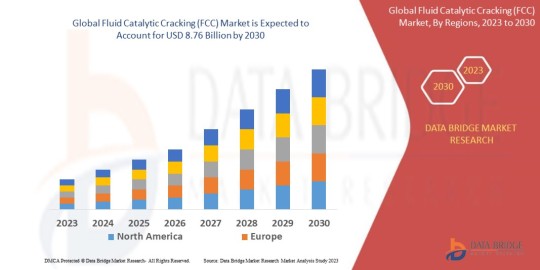
"Fluid Catalytic Cracking (FCC) Market Size And Forecast by 2030
According to Data Bridge Market Research analyses that the Global Fluid Catalytic Cracking (FCC) Market which was USD 6.73 Billion in 2022 is expected to reach USD 8.76 Billion by 2030 and is expected to undergo a CAGR of 3.35% during the forecast period of 2022 to 2030
Innovation remains at the core of Refinery Cracking Market success, driving growth and customer engagement. Fluid Catalytic Cracking (FCC) Market continuously invests in research and development to stay ahead of industry changes. By leveraging advanced technology, Crude Oil Processing Market enhances its solutions to meet consumer expectations. The strategic approach of Fluid Catalytic Cracking (FCC) Market ensures that new products and services remain competitive. Fluid Catalytic Cracking (FCC) Market remains a pioneer, delivering top-tier solutions with innovative strategies.
FCC Catalyst Market plays a crucial role in shaping global market trends through its dynamic approach. The influence of Fluid Catalytic Cracking (FCC) Market extends across industries, inspiring growth and development. Companies look to Hydrocarbon Refining Market as a benchmark for success, recognizing the brand’s leadership. By staying updated with consumer needs, Fluid Catalytic Cracking (FCC) Market maintains its strong position. The adaptability of Petroleum Cracking Market ensures continued influence in shaping industry patterns.
Our comprehensive Fluid Catalytic Cracking (FCC) Market report is ready with the latest trends, growth opportunities, and strategic analysis. https://www.databridgemarketresearch.com/reports/global-fluid-catalytic-cracking-fcc-market
**Segments**
- **Type**: The FCC market can be segmented based on the type of fluid catalytic cracking process, wherein the key types include light oil FCC, medium oil FCC, and heavy oil FCC. Each type caters to specific refining needs and product output specifications, influencing their demand in the market.
- **Catalyst**: Another crucial segmentation in the FCC market is the type of catalyst used in the process. Zeolite, ultrastable Y (USY), amorphous silica-alumina, and rare earth metals are among the commonly utilized catalysts, each offering distinct performance characteristics that affect the efficiency and output quality of the FCC process.
- **Feedstock**: The market can also be segmented based on the feedstock input to the FCC process. Crude oil, vacuum gas oil, resids, and other heavy hydrocarbons serve as feedstock for FCC units, with varying compositions and properties that impact the conversion rates and quality of products obtained.
- **End-User Industry**: Additionally, the global FCC market can be segmented by end-user industry, including oil refineries, petrochemical plants, and chemical processing facilities. The diverse requirements and product specifications of these industries influence the adoption of FCC technology and drive market growth.
**Market Players**
- **BASF SE**: A leading player in the FCC market, BASF SE offers a range of catalyst solutions for fluid catalytic cracking processes, focusing on enhancing efficiency, yield, and product quality for refineries worldwide.
- **Grace Catalysts Technologies**: With a strong presence in the FCC segment, Grace Catalysts Technologies provides innovative catalyst products and technical expertise to optimize FCC operations and maximize production output for its clients.
- **Albemarle Corporation**: Albemarle Corporation is a key player in the FCC market, offering a portfolio of catalysts and additives designed to improve process performance, reduce emissions, and meet stringent regulatory requirements in the refining industry.
- **Honeywell UOP**: Honeywell UOP specializes in providing advanced technologies and catalyst solutions for the FCC market, aiding refineries in achieving higher yields, operational flexibility, and compliance with environmental standards.
The global fluid catalytic cracking (FCC) market is dynamic and multifaceted, driven by evolving refining needs, technological advancements, and regulatory changes. The segmentation based on type, catalyst, feedstock, and end-user industry provides a comprehensive understanding of the market landscape, highlighting the diverse factors influencing market growth and competitiveness. Key players such as BASF SE, Grace Catalysts Technologies, Albemarle Corporation, and Honeywell UOP play a vital role in driving innovation, product development, and market expansion within the FCC industry, catering to the specific needs and challenges faced by refineries and petrochemical plants globally.
https://www.databridgemarketresearch.com/reports/global-fluid-catalytic-cracking-fcc-market The global fluid catalytic cracking (FCC) market continues to witness significant growth driven by various factors shaping the industry landscape. One key trend impacting the market is the increasing focus on sustainability and environmental regulations within the refining sector. As governments worldwide push for cleaner and more efficient processes, FCC technology is being leveraged to enhance energy efficiency, reduce emissions, and ensure compliance with stringent environmental standards. Market players are responding to this trend by developing innovative catalysts and solutions that not only boost process performance but also address sustainability concerns, thereby positioning themselves as key contributors to the industry's evolution.
Moreover, technological advancements play a crucial role in shaping the FCC market, with continuous R&D efforts aimed at improving catalyst formulations, reactor designs, and process optimization. Advancements in catalyst materials and composition are enhancing cracking efficiency, product selectivity, and overall operational performance of FCC units. Additionally, the integration of digital technologies such as AI and IoT in FCC operations is enabling real-time monitoring, predictive maintenance, and data-driven decision-making, leading to improved productivity and cost-effectiveness for refineries and petrochemical plants.
Another significant factor impacting the FCC market is the fluctuating demand patterns and supply dynamics in the global energy landscape. Volatility in crude oil prices, shifting consumption trends, and geopolitical factors all play a role in influencing the demand for FCC technology and related products. Market players are closely monitoring these trends to adapt their strategies, optimize production capacities, and capitalize on emerging opportunities in the evolving energy market.
Furthermore, the increasing focus on product diversification and value-added offerings is driving market competitiveness among key players in the FCC segment. Refineries and petrochemical facilities are not only seeking to maximize yield and efficiency but also aiming to produce higher-value products that cater to specific market demands. This trend is driving innovation in catalyst development, process optimization, and product differentiation, fostering a competitive environment where companies strive to differentiate themselves through unique solutions and tailored services.
In conclusion, the global FCC market is poised for growth and transformation, driven by key trends such as sustainability, technological advancements, evolving energy dynamics, and market competition. As market players continue to innovate, collaborate, and adapt to changing industry requirements, the FCC segment is likely to witness further advancements and developments that cater to the diverse needs of refineries, petrochemical plants, and chemical processing facilities worldwide.The fluid catalytic cracking (FCC) market is a vital segment within the broader refining and petrochemical industry, serving as a key process for converting heavy hydrocarbons into valuable lighter products such as gasoline, diesel, and other high-demand fuels and petrochemical feedstocks. The market segmentation based on type, catalyst, feedstock, and end-user industry provides a comprehensive framework for understanding the intricate dynamics at play within the FCC sector. Each segment caters to specific needs and requirements, influencing market demand, technological advancements, and competitive landscapes.
The type segmentation in the FCC market, comprising light oil FCC, medium oil FCC, and heavy oil FCC processes, reflects the diverse refining needs and product specifications within the industry. Different types of FCC processes are tailored to handle specific feedstocks and produce desired output products efficiently. This segmentation allows refineries and petrochemical plants to choose the most suitable FCC technology based on their operational requirements and product goals.
Catalyst segmentation is another critical aspect of the FCC market, with various catalyst types such as zeolite, ultrastable Y (USY), amorphous silica-alumina, and rare earth metals playing essential roles in the cracking process. Catalysts significantly impact the efficiency, selectivity, and stability of the FCC unit, influencing key performance indicators such as conversion rates, product quality, and emissions control. Market players are constantly innovating and developing new catalyst formulations to enhance process performance and meet evolving industry standards.
The feedstock segmentation in the FCC market highlights the diverse input sources for the cracking process, including crude oil, vacuum gas oil, and heavy hydrocarbons like resids. The choice of feedstock directly affects the yield, composition, and quality of the end products obtained from the FCC unit. Refineries and petrochemical plants strategically select feedstocks based on their availability, cost-effectiveness, and the desired product slate, emphasizing the importance of feedstock segmentation in optimizing FCC operations.
End-user industry segmentation sheds light on the varied applications of FCC technology across oil refineries, petrochemical plants, and chemical processing facilities. Each industry sector has unique product specifications, regulatory requirements, and operational challenges that influence the adoption and utilization of FCC technology. Market players catering to different end-user segments must tailor their products and services to address specific industry needs, ensuring compatibility, compliance, and efficiency in FCC operations.
In conclusion, the FCC market's segmentation based on type, catalyst, feedstock, and end-user industry provides a nuanced perspective on the complexities and opportunities present in this dynamic sector. Market players must navigate through these segments strategically, leveraging technology, innovation, and market insights to drive growth, enhance competitiveness, and meet the evolving demands of the global refining and petrochemical industry. By understanding and responding to the unique characteristics of each segment, businesses can position themselves for success and sustainability in the rapidly evolving FCC market landscape.
The market is highly fragmented, with a mix of global and regional players competing for market share. To Learn More About the Global Trends Impacting the Future of Top 10 Companies in Fluid Catalytic Cracking (FCC) Market : https://www.databridgemarketresearch.com/reports/global-fluid-catalytic-cracking-fcc-market/companies
Key Questions Answered by the Global Fluid Catalytic Cracking (FCC) Market Report:
What is the current state of the Fluid Catalytic Cracking (FCC) Market, and how has it evolved?
What are the key drivers behind the growth of the Fluid Catalytic Cracking (FCC) Market?
What challenges and barriers do businesses in the Fluid Catalytic Cracking (FCC) Market face?
How are technological innovations impacting the Fluid Catalytic Cracking (FCC) Market?
What emerging trends and opportunities should businesses be aware of in the Fluid Catalytic Cracking (FCC) Market?
Browse More Reports:
https://www.databridgemarketresearch.com/reports/global-capnography-device-markethttps://www.databridgemarketresearch.com/reports/us-anorexiants-markethttps://www.databridgemarketresearch.com/reports/global-automotive-software-markethttps://www.databridgemarketresearch.com/reports/global-micro-mobility-markethttps://www.databridgemarketresearch.com/reports/global-holographic-blister-foil-market
Data Bridge Market Research:
☎ Contact Us:
Data Bridge Market Research
US: +1 614 591 3140
UK: +44 845 154 9652
APAC: +653 1251 1003
✉ Email: [email protected]"
#Refinery Cracking Market#Crude Oil Processing Market#FCC Catalyst Market#Hydrocarbon Refining Market#Petroleum Cracking Market#Oil Upgrading Technology Market#Catalytic Refining Process Market#Advanced Fuel Processing Market#FCC Equipment Market#High-Efficiency Cracking Market
0 notes
Text
#cisco#catalyst#C9500#12 ports#40g#switch#nw advance license#c9500-12q-a#amazon#ebay#walmart#newegg#alcatel#lucent#nokia#sharp
0 notes
Text
People keep saying that skibi.. skibiwhateverthefuck is roughly the same thing as YouTube Poop and earlier GMod animations but they're... not? YTPs initially weren't made to entertain at all, they were meant to gum up the search results when you wanted to find something else--that's why they were called YouTube poop. They were shit. The first ones focused on being as loud and obnoxious as possible--some of the hallmarks of early YTPs (loud noises, flashing colors, repetition) exist because of this. They weren't made with children in mind, and as they evolved they became more elaborate and started to display plotlines as people began to find them funny and seek them out on their own. Aside--It's oft forgotten that "poopers" (and those that enjoyed them by extension) were and are a community, and as things changed someone would be relentlessly mocked for the sorts of things that would appear in early YTP. The comments would be filled with other teens and adults being incredibly virulent (and offensive) about how shit the video was in these cases, and not in an ironic way. These were made for an older audience with an older audience in mind. It's the same with everything else people compare to the toilet animation--these things were aimed at teens and up, not children. If children got their hands on them it was because someone older than them was like "hey, you wanna see something funny?" Next someone's going to say YTMNDs were the same thing, when, again, they were not meant for children and had just as scathing and offensive a community as the YTP one, if not even moreso. You watched these were things in high school. High schoolers quoted them to one another, not elementary schoolers--that's why millennials are all like "*holds up spork* the penguin of doom is stealing my sanity", because these were like. Shit you shared over AIM and MySpace with your school buds? They were shared among the offensive "lolsorandom" nerdy edgelords and saw a little bit of bleed but were a niche thing even then.
#advanced deltawave#Good lord???? Does no one remember how offensive early YTPs were?! They were made to be repulsive!#I think MrSimon and NintendoBrad in particular might have been catalysts for moving away from the initial form....?#I might be mistaken--in any case they weren't for kids. They never pretended to be nor wanted to be#I mean. I should know. I was there when the “where there's smoke they pinch back” bumper became a thing and the YTP forum was made
0 notes
Text
Well, back. I'm really at the point where the next step is - I'm at the point I'm running out of steps other than - connecting astral body with physical body, so I guess time to focus on that.
#I am so incredibly bored and boredom is just stifling all progress#And I'm bored because nothing I do is tangible. Nowhere I go exists and no one I interact with exists outside of my head#I'm trying to not let the ''time to tear the veil down and go crazy go stupid'' side of me out but also. lmfao. That's mw#Me*. Advancement and the catalyst. Progress and the channel in between. Time to just exist as that#~abyssal murmurs
1 note
·
View note
Text
From a popular JP One Piece theorist:

...So you're definitely not the only one, OP. Zoro is clearly intended to be Luffy's mirror, sword and shield.






Zoro's official number is 1111 and Chapter 1111 of the manga is titled The Sun's Shield. Although some may argue that Zoro is Luffy's sword and Sanji should be the shield, I personally think that Zoro deserves to be called Luffy's shield too for all the times Zoro protected his Captain, whether Oda purposely named the chapter that way or not.
#Sanji is the catalyst for TWO excellent story arcs!#Zoro ALWAYS puts Luffy's best interests first!#Your fave can do one of these things. But not both. And that's okay!#Zoro was designed to shore up Luffy's weaknesses; while Sanji is designed for other (important!) things#of course Sanji supports Luffy. And he is very good at putting up a unified front with Zoro in order to help Luffy *advance forward*#but imo Usopp & Jinbe are the only two crewmembers who are really comparable to Zoro in terms of being the ones#who protect and uplift Luffy when he's at his most vulnerable#the main difference is: Usopp is way more emotionally reactive. And Jinbe doesn't necessarily understand how Luffy operates#so Zoro is still the primary character who fills that role#while Usopp & Jinbe step in when appropriate#long post#zolu#meta#monkey d. luffy#roronoa zoro#one piece
191 notes
·
View notes
Text
#Advanced Catalyst Recovery Filters#Catalyst Filters#Catalyst filtration#Catalyst filtration process#Catalyst Recovery filter Systems#Sintered powder metal filter#Catalyst Filtration and Catalyst Trapping applications#Raney Nickel Catalyst Filters#sinter filter cartridges#Zinc Oxide Catalyst Recovery Filters
1 note
·
View note
Text
Global Biodiesel Catalyst Market Is Estimated To Witness High Growth Owing To Increasing Demand for Sustainable Fuel Alternatives

The global Biodiesel Catalyst Market is estimated to be valued at US$ 231.5 million in 2023 and is expected to exhibit a CAGR of 5% over the forecast period 2023-2030, as highlighted in a new report published by Coherent Market Insights. Market Overview: Biodiesel catalysts are used in the production of biodiesel, which is a renewable fuel derived from vegetable oils or animal fats. Biodiesel offers several advantages over conventional diesel, such as reduced greenhouse gas emissions, improved engine performance, and increased energy security. The growing concerns over environmental pollution and the depletion of fossil fuel resources have led to an increased demand for sustainable fuel alternatives like biodiesel. Biodiesel catalysts play a crucial role in the conversion of vegetable oils or animal fats into biodiesel by facilitating the chemical reactions involved. These catalysts help improve the reaction kinetics, yield, and overall efficiency of the biodiesel production process. Market Key Trends: One key trend driving the growth of the biodiesel catalyst market is the increasing adoption of renewable energy sources and the implementation of stringent environmental regulations worldwide. Governments and regulatory bodies across the globe are promoting the use of biodiesel as an alternative to fossil fuels. For instance, in the European Union (EU), member states are required to ensure that at least 10% of their transport fuels come from renewable sources by 2020. Similarly, countries like the United States, Brazil, and Indonesia have set targets for increasing the share of biofuels in their respective transportation sectors. This growing focus on renewable energy and sustainable transportation fuels is expected to drive the demand for biodiesel catalysts. PEST Analysis: - Political: Governments worldwide are implementing favorable policies and regulations to promote the production and use of biodiesel. This includes incentives, tax credits, and mandates for blending biodiesel with conventional diesel fuels. - Economic: The growing demand for biodiesel as a sustainable fuel alternative is creating economic opportunities for biodiesel catalyst manufacturers. Additionally, the increasing crude oil prices are making biodiesel a more cost-effective option for end-users. - Social: There is a growing awareness among consumers about the environmental benefits of biodiesel, leading to an increased demand for cleaner fuel options. The use of biodiesel is also seen as a way to reduce dependence on foreign oil and support local agricultural economies. - Technological: Advancements in catalyst technologies are leading to improved catalyst performance, higher conversion efficiencies, and reduced production costs. New catalyst formulations and manufacturing processes are being developed to enhance the overall efficiency of the biodiesel production process. Key Takeaways: - The global Biodiesel Catalyst Market Scope is expected to witness high growth, exhibiting a CAGR of 5% over the forecast period due to increasing demand for sustainable fuel alternatives. - North America is expected to be the fastest-growing and dominating region in the biodiesel catalyst market. The region has a well-established biodiesel industry and favorable regulatory policies promoting the use of biofuels. - Key players operating in the global biodiesel catalyst market include BASF SE, Evonik Industries AG, Clariant AG, DuPont de Nemours, Inc., Albemarle Corporation, Arkema SA, Johnson Matthey PLC, Mitsubishi Chemical Corporation, Honeywell International Inc., Shell Catalysts & Technologies, W. R. Grace & Co., Haldor Topsoe A/S, Dow Chemical Company, CRI Catalyst Company, and Sud-Chemie India Pvt. Ltd. (Clariant India Ltd.).
#Biodiesel Catalyst#Biodiesel Catalyst Market#Biodiesel Catalyst Market Analysis#Biodiesel Catalyst Market Growth#Biodiesel Catalyst Market Scope#Advanced Materials
0 notes
Text

Catalyst
so in my au which i'm totally not using to cope or anything haha, after realizing that curly isn't going to do anything about jimmy, anya confides in swansea and he goes Protective Dad Mode. i'm calling this the "Responsibility AU." ramble below cut.
swansea doesn't immediately go after jimmy with an axe or anything because 1. they're not in a high stress life/death crash situation and 2. anya specifically requests that swansea not enact violence upon jimmy after swansea says, and i quote, "i'm gonna beat his ass." anya just wants to feel safer and more supported on the ship—she doesn't want swansea to get in trouble even if jimmy does deserve to get destroyed by 10000 punches.
what swansea can do is watch out for anya and make sure she's never alone in a room with jimmy. if there's a situation where she has to be alone with jimmy (like the psych evals), she and swansea have a system where she can signal for help. with anya's permission, swansea asks daisuke to help look out for her too (without telling him the details as to why since that's anya's right to share or not). daisuke has already picked up at this point that something is wrong based on how much more hostile swansea's become towards jimmy, and he trusts his boss, so he agrees without much question.
anya, feeling less alone now that she has people watching her back, gains more confidence to stand up to jimmy. which makes him angry because his unwanted advances are being denied and swansea and daisuke keep getting in his way. he just can't understand why he's being treated as the bad guy here (this is because he is a delusional asshole).
meanwhile curly is slowly realizing that he needs to actually do something here because the tension in the crew is palpable and increasing by the day. also swansea is being mighty passive aggressive to him and talking about "responsibility" a lot. curly keeps trying to talk to jimmy about it but the guy just keeps downplaying it and blaming everyone else but himself. and curly is realizing that his friend isn't who he thought he was.
it all comes to a head one day when an angry jimmy tries to confront anya alone and swansea steps in. things get heated, people start yelling. curly show up to see swansea and jimmy on the verge of fighting with anya and daisuke trying to hold them back respectively. curly breaks up the fight. jimmy storms off. curly follows him and finds him trying to get the gun from the case in the cockpit. curly asks him why he's doing this and jimmy claims it's for his own protection because he feels "threatened by swansea." he tells curly to give him the code. curly, the sheer wrongness of the whole situation hitting him, finally calls jimmy out on all his bs. jimmy just laughs in his face, still believing that he's not in the wrong and curly doesn't have the guts to do anything anyway. so the captain fires him on the spot. jimmy snaps and he and curly get into a fight in the cockpit. jimmy is trying to crash the ship and curly is trying to stop him. then the rest of the crew show up and anya knocks jimmy's ass out with the gun case. swansea is so proud.
they throw jimmy in the cryopod so they don't have to worry about him pulling anything else and he can be properly dealt with once the stupid delivery is over. everyone's like, "wow that was a close one—could you imagine how messed up it would be if we ended up in a crash because of jimmy? thank god that didn't happen." curly makes swansea the copilot until they can get a replacement and swansea's like, "goddammit as if i don't already do enough shit around here."
anyway my whole goal here was to get rid of jimmy early so i can have beautiful Found Family shenanigans in space with the rest of the crew. apologies and healing and happy times will happen. no the whole getting laid off thing doesn't happen. no i don't have an explanation for it. sorry for the essay.
1K notes
·
View notes
Text
Refinery Catalyst Market Technological Advancements And Covid-19 Impact Analysis

The Refinery Catalyst Market has undergone significant technological advancements in recent years, coupled with a noteworthy analysis of the impact of the Covid-19 pandemic on the industry. Refinery catalysts play a crucial role in enhancing the efficiency and yield of various refining processes, such as hydrocracking, fluid catalytic cracking (FCC), and hydrotreating. These catalysts facilitate the conversion of crude oil into valuable products like gasoline, diesel, and petrochemicals.
In terms of technological advancements, researchers and Refinery Catalyst Market players have been focusing on developing catalysts with improved activity, selectivity, and stability. The integration of nanotechnology has led to the creation of nanostructured catalysts, which exhibit higher surface areas and better catalytic properties compared to traditional catalysts.
Additionally, the use of advanced materials, such as zeolites and metal-organic frameworks (MOFs), has enabled the design of catalysts tailored for specific refining processes, leading to enhanced performance and product quality. The development of intelligent catalysts embedded with sensors and data-driven capabilities has also gained momentum, enabling real-time monitoring and optimization of refining operations.
However, the technological advancements in the Refinery Catalyst Market have not been immune to the disruptions caused by the Covid-19 pandemic. The outbreak of the virus led to widespread lockdowns, supply chain disruptions, and reduced demand for refined products due to restrictions on travel and economic activities. As a result, many refineries faced challenges in maintaining their operations and adjusting their production levels to align with the decreased demand. This had a direct impact on the catalyst market, as refinery operators postponed or scaled back their catalyst procurement plans.
The pandemic also highlighted the importance of resilience and adaptability in the refining industry. Refineries that were able to quickly implement remote monitoring and control systems, as well as adopt digital solutions for catalyst management, were better equipped to navigate the challenges posed by the pandemic. This experience accelerated the industry's shift towards digitization and the adoption of Industry 4.0 principles, further driving technological innovation in catalyst development and deployment.
Crude Oil Flow Improvers refer to a class of innovative substances utilized within the oil and gas industry to optimize the movement of crude oil from extraction sites to processing facilities.
The Refinery Catalyst Market has witnessed significant technological advancements that have revolutionized the way catalysts are designed and utilized in refining processes. However, the Covid-19 pandemic served as a stark reminder of the industry's vulnerability to external shocks and the need for greater flexibility and digitalization. As the world recovers from the pandemic and the demand for refined products rebounds, the market is likely to continue its trajectory of innovation, with a renewed emphasis on technological solutions that enhance efficiency, sustainability, and resilience in the face of future challenges.
#Refinery Catalyst Market#Refinery Catalyst Market Insights#Coherent Market Insights#Refinery Catalyst Market Technological Advancements#Refinery Catalyst Market Covid-19 Impact Analysis#energy#crude oil#petroleum refineries#sustainable#artificial intelligence#fuels
0 notes
Text
Geology of Natural Disasters and How to write them into your fictional universe.
So, you want to write about a natural disaster to advance your plot and torture your players/characters even more? Let me tell you how, accurately.
I feel like unless it is a volcano, natural disasters are a pretty slept on plot drivers, and some of them are really cool and unique! Today, I will talk to you about land slides, earthquakes (And earthquake related disasters), and volcanoes.
Landslides: Probably one I see the least in stories, but one that would be incredibly interesting to write into a plot where they believe in curses. Landslides can happen along ocean bluffs, slightly hilly areas, and highly mountainous areas, this means it is something that can happen in most landscapes. But what can trigger a landslide? Mostly all you need to trigger a landslide could be just abnormally large amounts of rain, excessive deforestation (with a little bit of rain), or an earthquake. If you don't want to use deforestation or an earthquake as a catalyst, a really cool indicator that the land is slipping and may be prone to a collapse is J hooked trees.

This indicates that there is soil creeping slowly over time, and it may lead to a major landslide.
2. Earthquakes: Probably one of the easiest things to write, earthquakes can happen anywhere, but they are most common in places that are tectonically active areas. There are about three types of environments you can expect earthquakes to be common. The first is just rugged mountains, if your landscape looks like this, you should write in earthquakes. Associated hazards could be landslides, avalanches, and large falling rocks.

The next landscape could be a thin mountain range, next to the ocean, very scenic, but very dangerous. Essentially, I am describing a subduction zone environment.

Earthquakes in these areas could equal a couple different associated disasters. Scenario one: A very large earthquake happens, and the ocean begins to recede. This is a tsunami, enough said. If you are writing a tsunami though, please, please, do not write it as a large wave, thank you. Also, a common way people are hurt by tsunami's are from them going into the ocean because they don't understand a tsunami is going to happen.
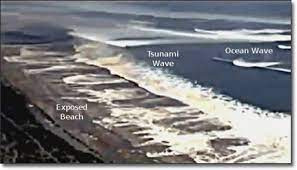
Scenario two: A large earthquake happens, your characters are in a valley and suddenly the ground begins to liquify as the ground shakes, once the shaking stops, the ground becomes solid like nothing ever happened, except everything has suddenly sunk into the now hard ground. This is called liquefaction and it typically happens in areas that have loose dirt or lots of saturated soil.
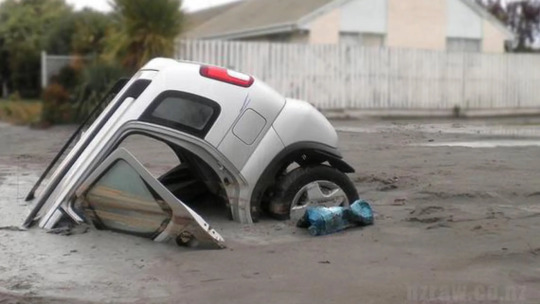
Scenario three: There are a lot of small earthquakes, they do not cause a lot of damage, but you begin to notice that one of the isolated mountains has a plume rising. Earthquakes can indicate lava moving underground and the filling of magma chambers.
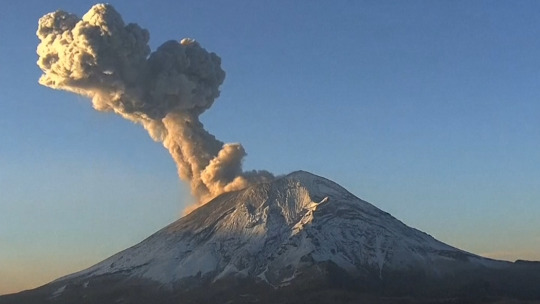
The next environment that can host lots of earthquakes would be regions that have a lot of really deep valleys and small mountain ranges (not cone volcanoes), but overall seems pretty flat.

This indicates a transform fault like the San Andreas. If you want to hint at there being earthquakes in the area, you can show fence posts that are suddenly several feet out of line at a dilapidated farm or something similar.
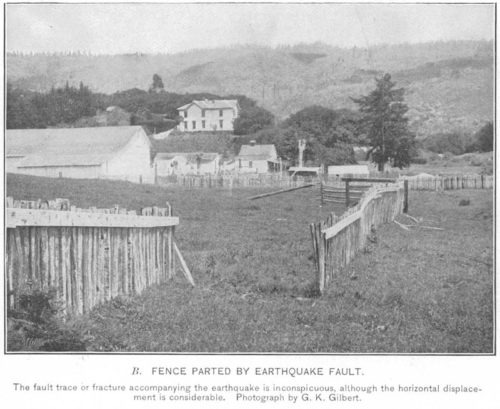
(These earthquakes are different because they are cased from sideways movement, not an up-and-down movement this hint can only be used for this environment). Volcanoes would not be found here, but liquefaction and landslides could still occur here.
4. Volcanoes: If you thought earthquakes had a lot of information, volcanoes do too. First you have to ask yourself, what kind of volcano you want to have, what kind of eruption style? So lets break down the kind of eruptions you can have and what their landscapes look like. Hawaiian Shield volcano: This will produce a smooth fast lava, the landscape typically is pretty flat, but there will be small cones and the rocks can have a ropey or jagged texture and the rocks will be almost exclusively black to dark red.
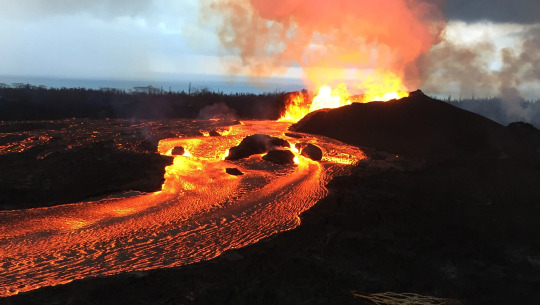
Stratovolcanoes: These will be solitary mountains, typically, that look like perfect cones (Picture shown in earthquake section). These will have large ash cloud eruptions and pyroclastic flows, they may have some lava, but typically most damage is done from the pyroclastic flows (think Pompeii). Some hints of these, other than describing the cone features (which can be hidden by other mountains), would be to talk about petrified wood! Trees can get fossilized in the ash and I imagine it would be very strange to find this rock that clearly looks to be a piece of wood, but its a rock. Subcategory- Calderas: Used to be a large stratovolcano, but they erupt so explosively that the entire cone collapses and creates a basin.
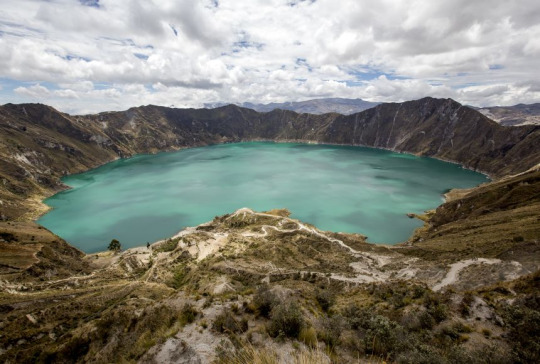
There are a lot of kinds of volcanoes out there, so forgive me for just putting an infographic and then talking to you about these really rare types of eruptions that I feel like people should know about.
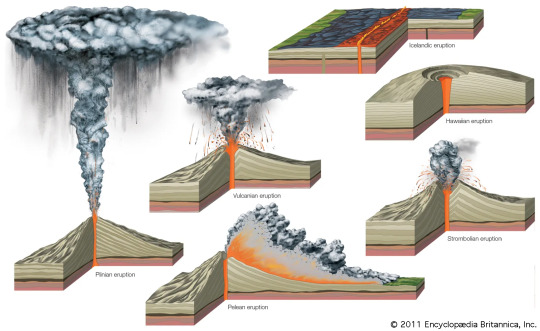
Okay lets talk about blue lava (kind of) and black lava

You will notice the lava is still red in the middle of this image, during the day these would look like a normal eruption, but at night the burning sulfur would make it appear blue. Some cool features other than this, would be that any water in the area would become very acidic and burn the skin due to sulfuric acid. This would again be really cool if you are trying to describe a 'cursed' land.
Black lava: This happens only in the east African rift I believe, but it is a carbonatite lava, but if you are writing in a rift valley (where the continent is tearing apart to form a new ocean) this might be a cool feature. The lava will cool white and will quickly erode, it makes for a very alien landscape!

Anyway as always, this is supposed to be an introductive guide for the basics of writing geology to create cool landscapes/features into dnd or fictional universes, if you are a geologist please understand my oversimplification of tectonics, I didn't want people to run away.
#geology#rocks#stem#dnd#dnd worldbuilding#worldbuilding stuff#fictional world#worldbuilding#fictional writing#writing resources#creative writing
5K notes
·
View notes